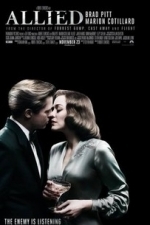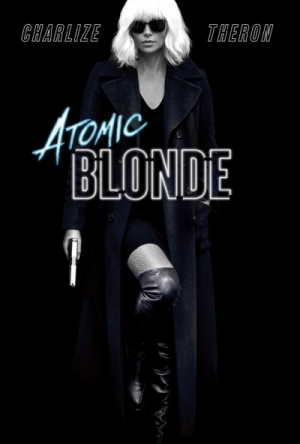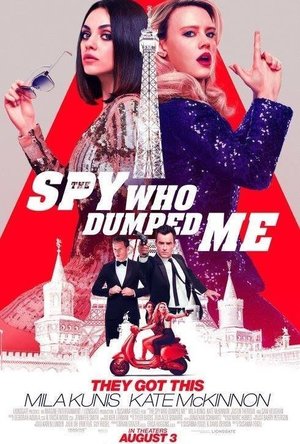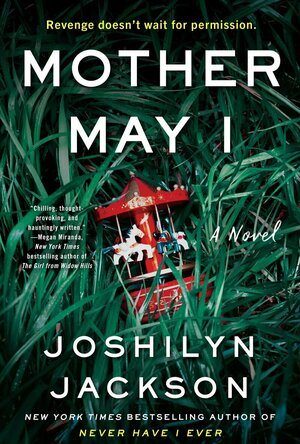
Mother May I
Book
The New York Times bestselling author of the critically acclaimed Never Have I Ever builds on her...
Domestic Suspense Suspense family

Agent Gumball - Roguelike Spy Game
Games and Entertainment
App
Someone’s been spying on Gumball. What the what?! Two can play at that game! GO UNDERCOVER Sneak...
Darren (1599 KP) rated Allied (2016) in Movies
Jun 20, 2019
After a year of marriage Heslop comes to Max believing Marianna is indeed a spy, this leaves Max questioning, which side of the story to believe and what is the truth.
Thoughts on Allied
Characters – Max Vatan is Canadian intelligence working in Africa, highly skilled he can blend into his environment, but he does fall in love with his undercover wife. When he gets informed she could well be a spy, his life is turned upside down with doubts about what is the truth. Marianna is the French resistance fighter working with the Canadian Max as his fake wife, but she also falls in love with Max and returns to start a family with him. We don’t learn too much apart from that she is a loving wife and mother though.
Performances – Brad Pitt is good for the opening mission, you believe his every decision, but when he becomes the family man, he just doesn’t reach the levels you know he can. Marion Cotillard is good without being her breath-taking best in this role.
Story – The story here follows love and spies during World War II, we see how two people from different sides of the war fall in love and they must decide which side of the war they are supporting. This film doesn’t become as intense as it could be because seeing it from both sides could have heighted the experience and by the end it just doesn’t feel like it reaches the levels it should.
Action/Romance/War – The action during the film is tame with very little being used or looking overly real. The romance doesn’t feel whirlwind like you think it should be either, but the war side comes off strong as we see how the tension between the sides cause most of the issues in the lives.
Settings – The settings look authentic for the time, which does work well for the film.
Scene of the Movie – The truth.
That Moment That Annoyed Me – Just fizzles out in the second half of the film.
Final Thoughts – This is a war romance film that just never reaches the levels it should do, it just seems to go on and becomes one of the average films that you forget by the end.
Overall: Average and disappointing.
https://moviesreview101.com/2019/02/01/abc-film-challenge-oscar-nomination-a-allied-2016/

The Robot Factory by Tinybop
Education and Games
App
Create robots. Test robots. Collect robots. Build with exoskeletons, zephyr mechanisms, hydrostatic...
Movie Metropolis (309 KP) rated Atomic Blonde (2017) in Movies
Jun 10, 2019
Just this year he signed on to direct Deadpool 2 after Tim Miller’s sudden departure. In the meantime, he’s treating us to another adults-only thriller, Atomic Blonde. But is this Charlize Theron-led vehicle as good as his previous work?
Sensual and savage, Lorraine Broughton (Charlize Theron) is the most elite spy in MI6, an agent willing to use all her skills to stay alive during impossible missions. With the Berlin Wall ready to crumble, she travels into the middle of the city to retrieve a dossier and take down an espionage ring. Once there, she teams up with an embedded station chief (James McAvoy) to navigate her way through the deadliest game of spies.
Charlize Theron is fast-becoming one of Hollywood’s most bankable stars after decent turns in Fast & Furious 8 and Mad Max: Fury Road. In Atomic Blonde this is no exception. She commands the screen in each and every frame, oozing class and showing the world she is a first-class action superstar.
The rest of the cast are also exquisite. James McAvoy can do no wrong this year after his out-of-this-world performance in Split, and his David Percival here is fleshed out, well-written and beautifully acted. Elsewhere, John Goodman and Toby Jones add even more prowess to proceedings.
Add to this some stunning cinematography and you’ve got a recipe for success. Atomic Blonde relishes the era in which it is presented with a magnificent soundtrack and beautiful direction. Leitch makes the film feel very much alive, with brutally realistic action shot without needless shaky cam or over-the-top scoring.
Unfortunately, the story is less successful. If Theron is the living, beating heart of Atomic Blonde, the script nearly strangles her. It is nearly impossible to truly understand what is happening on screen as the plot throws more twists and turns at the audience than Spaghetti Junction. Ordinarily, this would be great, but here it’s distracting and nonsensical.
Nevertheless, this is a vastly entertaining film, very much in the same vein of John Wick. In fact, it’d be fantastic if we could see these two characters brought together in a crossover of epic proportions.
Overall, David Leitch hasn’t quite recaptured the success of his first feature film but has managed to craft a highly stylised and quick-moving thriller that feels very real and utilises its exceptional cast incredibly well, with Charlize Theron being an absolute delight. It’s just unfortunate the plot is a bit of a damp squib.
https://moviemetropolis.net/2017/08/10/atomic-blonde-review-say-hello-to-mrs-john-wick/
Lee (2222 KP) rated The Spy Who Dumped Me (2018) in Movies
Aug 21, 2018
Mila Kunis is Audrey, celebrating her birthday in a bar. Only her celebrations have been ruined somewhat by the fact that her boyfriend Drew (Justin Theroux) recently dumped her. By text! She's with best friend Morgan (Kate McKinnon), and as they complain about Drew, we see that he's in a spot of bother of his own over in Europe - taking out bad guys in a market shootout, getting chased through somebody's apartment while the owners watch TV, jumping out of a window onto a truck, and casually strolling out of a building as it explodes behind him. But when Audrey sends him yet another text, this time threatening to burn all of his stuff, Drew quickly gets in touch with her. Turns out that a small trophy in among his little box of dirty undies and other possessions is the key to saving a lot of people, and the bad guys want to get their hands on it at all costs. So, Audrey and Morgan unwittingly become involved in the world of spies and villains, traveling around Europe and bumbling their way through all manner of problems to ensure that the trophy finds its way into the right hands.
As mentioned earlier, every effort has been made to make sure that this is a high action spy movie along the lines of the Bourne and Mission Impossible movies. The aforementioned escape from the bad guys, a huge restaurant shootout, a deadly villain, a high speed street chase involving cars, motorbikes and guns, not to mention almost as much double crossing/who can you trust shenanigans than MI: Fallout recently, are all present and presented really well. All the while, Audrey and Morgan bring lighthearted relief and humour to it all. Kunis and McKinnon doing exactly what we're used to from their separate movie comedies but coming together here as a really likeable team and with a good supporting cast too.
Overall, The Spy Who Dumped Me isn't too bad, but it isn't too great either. It also seemed to drag on way too much for my liking and I would have preferred a much tighter movie, with a few more laughs. Still fairly enjoyable though.
Russell Evans (179 KP) rated Tyrants of the Underdark in Tabletop Games
Feb 24, 2020 (Updated Feb 24, 2020)
A brief overview of the Game
Each player controls a Drow house in the Underdark, competing to take control by getting the most Victory Points at the end of the game. Victory points are gained from various sources, for example, controlling locations on the board, assassinating your rivals troops, card abilities, cards owned in your deck or promoted.
Each turn the player draws cards from their own deck that determine what they can do in their turn. There are several different strategies you can pursue to try and win – subterfuge, violence, using spies, gathering a powerful deck etc. You can use influence that you gain in the game to buy new cards from the communal market to expand your deck and buy new minions with a range of different abilities. Random card drawers in the market can be frustrating when your opponents get the card you want straight after your turn, but that’s the nature of the game. Some of the cards can seem super–powered but there are several of these, so we find it balances out overall.
The promotion mechanic is rather interesting - it gives you the dilemma of promoting a card to gain increased victory points but means that the card (and its abilities) aren’t available for you to use for rest of the game. Do you hang on to it a bit longer to use that awesome ability and risk the game ending before you can promote that card for loads more victory points?
There are 4 decks included in the base game; Drow, Dragons, Elementals and Demons and they all play very differently. You use a mix of 2 decks each game, so that adds a bit of variety and re-playability. (Add in the 2 from the expansion for a bit more – Aberrations and Undead.)
Also worth mentioning; the artwork on the cards is nice and the board is good too.
I think Tyrants of the Underdark is a very enjoyable game and it gets a solid 9/10. I just wish there were some more expansions for it.
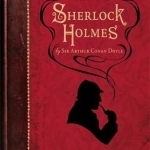
The Penguin Complete Sherlock Holmes
Book
The Penguin Complete Sherlock Holmes by Arthur Conan Doyle are the complete adventures of the...
Night Reader Reviews (683 KP) rated Secrets in Books
Nov 18, 2020
Posy Waiters’s is a fifteen year old girl who has always questioned her parent’s love for her. This is mainly because she hardly knows them since they travel all the time for work and rarely see her. Sometimes they even forget to send her a card on her birthday. Posy lives all alone except for the live-in nanny who is only there for the money Posy’s parents are paying her. One day all this suddenly changes.
Posy’s parents tragically die and leave Posy to their friends whom Posy has never even heard of let alone met. Her greedy nanny doesn't even stick around to help her pack after hearing the news. Now Posy is living in San Francisco with the Forests but things are not quite what she thinks. While exploring the cellar of her new home Posy discovers something that will change her life forever.
I just loved how many twists there were in this book, some of which actually surprised me. One of the biggest surprises actually appeared at the very end of the book and was a real shocker (though it left a bunch of questions I feel will go unanswered as I don’t believe there is a sequel coming). I also enjoyed the loyalty and non-judgmental attitude for the friends, a rare trait anymore. There are quite a few errors in the book but that is not my largest complaint. My main issue is just how oblivious Posy and Alex are frequently. I also felt like the author occasionally forgot how old (or young) the characters are, such as when a sixteen year old Posy buys a cocktail dress.
Teens to young adults would probably like this book the most. This is largely because it doesn't go into a lot of detail. I also don’t believe the unanswered questions will bother younger readers as much. However, incest is a big subject in this book (and sex is hinted at) and those unable to handle it should refrain from reading this book. I rate this book 2 out of 4 or 3 out of 5. The book would have been much better if it answered ore of the question that it created. That along with the errors and age appropriate behavior (or lack there of) of the characters really damaged my view of the book. If going off of the plot alone I would say the book is extremely good.

Angry Birds Star Wars HD
Games
App
JOIN THE ANGRY BIRDS IN THEIR BIGGEST ADVENTURE YET! A long time ago in a galaxy far, far away... a...
